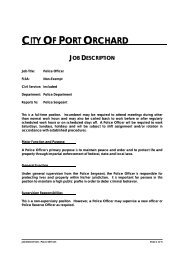Corridor-Level Environmental Site Assessment - City of Port Orchard
Corridor-Level Environmental Site Assessment - City of Port Orchard
Corridor-Level Environmental Site Assessment - City of Port Orchard
Create successful ePaper yourself
Turn your PDF publications into a flip-book with our unique Google optimized e-Paper software.
MOSQUITO FLEET TRAIL PROJECT • <strong>Port</strong> <strong>Orchard</strong>, Washington<br />
General <strong>Corridor</strong>-Specific Contamination<br />
The <strong>Corridor</strong> is located in a commercial and residential area. There is the potential to encounter<br />
contamination in the soil and groundwater due to the use <strong>of</strong> petroleum hydrocarbons and/or dry<br />
cleaning solvents from past use <strong>of</strong> these materials in the area.<br />
The western portion <strong>of</strong> the <strong>Corridor</strong> was filled between 1965 and 1980 based on the geologic map,<br />
Sanborn maps and aerial photographs. The source <strong>of</strong> the fill is unknown and may contain<br />
contaminated soils.<br />
We understand several houses on the east end <strong>of</strong> the <strong>Corridor</strong> will be directly impacted by<br />
construction activities in the <strong>Corridor</strong>. The Kitsap County Assessors website indicates the<br />
residences were built between the 1910s and 1950s with heating systems listed as forced air.<br />
Heating oil storage tanks can be associated with residences and commercial structures <strong>of</strong> this age<br />
and type <strong>of</strong> heating. We understand the houses will not be demolished but that minor grading and<br />
sidewalk construction is planned for the <strong>Corridor</strong> in this area. Managing potential contamination<br />
associated with heating oil tanks will likely be the responsibility <strong>of</strong> the <strong>City</strong> <strong>of</strong> <strong>Port</strong> <strong>Orchard</strong>.<br />
Blackjack Creek crosses the central portion <strong>of</strong> the <strong>Corridor</strong>. The Creek receives stormwater from<br />
areas that contain undeveloped, residential and commercial properties. There is the potential for<br />
low concentrations <strong>of</strong> contaminants to be present in stormwater run<strong>of</strong>f.<br />
Contamination from heating oil tanks and stormwater run<strong>of</strong>f are all considered low environmental<br />
concerns with respect to the project.<br />
CONCLUSIONS AND RECOMMENDATIONS<br />
Six properties were identified as environmental sites <strong>of</strong> concern. ROW acquisition is planned<br />
where the proposed alignment is located adjacent to an existing <strong>City</strong> <strong>of</strong> <strong>Port</strong> <strong>Orchard</strong> ROW. The <strong>City</strong><br />
<strong>of</strong> <strong>Port</strong> <strong>Orchard</strong> plans to acquire easements where the proposed alignment is not located adjacent<br />
to existing ROW. Risks <strong>of</strong> encountering contamination were evaluated based on readily available<br />
information and this report does not constitute a Phase I ESA per ASTM International (ASTM) 1527-<br />
05. Four low-risk sites, two moderate-risk sites and no high-risk sites were identified during our<br />
study. A brief description <strong>of</strong> each site is outlined in Table 1. The locations <strong>of</strong> the sites are shown in<br />
Figures 3 through 7.<br />
Our recommendations for further action to mitigate potential impacts are as follows:<br />
■ ROW acquisition is planned as part <strong>of</strong> the project within <strong>Site</strong>s 1 and 6. A Phase I ESA per ASTM<br />
Standard E 1527-05 on <strong>Site</strong>s 1 and 6 prior to ROW acquisition is recommended. A Phase II<br />
ESA including subsurface investigation may be recommended based on the findings <strong>of</strong> the<br />
Phase I ESA.<br />
■ Contaminated media, hazardous wastes and/or USTs encountered during construction<br />
activities should be managed in accordance with environmental regulations. The bid<br />
documents should require the earthwork contractor and other personnel that could potentially<br />
contact contaminated materials comply with training requirements for handling contaminated<br />
May 23, 2011 | Page 7<br />
File No. 12309-009-00




